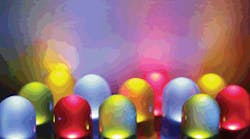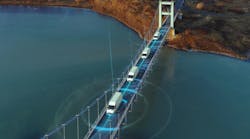Held on March 21 at the Hotel Pennsylvania in New York, the Sixth Annual LEDucation conference, presented by The Designers Lighting Forum of New York (DLFNY) with the support of the New York Section of the Illuminating Engineering Society (IESNA), helped more than 2,000 lighting industry professionals learn more about solid-state light sources, standards, and controls. The meeting offered four seminars and an exhibit area with more than 92 manufacturers and distributors showing their products and services throughout the day and evening. Following are some trends and highlights from these presentations.
-
In “LED Standards Update,” Naomi J. Miller, Pacific Northwest National Laboratory (PNNL) and Alex Baker, Energy Star, reviewed the major undertakings of the DOE’s solid-state lighting initiatives aimed at validating the selection of LED products. The programs include the “L prize,” a competition to develop a suitable replacement for the incandescent bulb and the Next Generation Lighting (NGL) Luminaire design competition, first begun in 2008.
Another DOE effort, Round 13 of the CALiPER testing program for LED products, released at the end of 2011, shows that solid-state light source products can match existing sources in some commercial and light industry applications, such as 2 ft by 2 ft troffer fixtures, high-bay luminaires, and wallpacks.
LED lighting is making its biggest push in the outdoor lighting market, thanks to improved optics and thermal management techniques, and the DOE is promoting LED street lighting through a number of projects. Additionally, the DOE’s Municipal Solid-State Street Lighting Consortium has an economic cost-benefit analysis tool to help estimate the cost of changing existing roadway lighting units (street and highway) to LED sources.
In the presentation, Miller recommended accessing some of the tools available at DOE’s Lighting Facts program to help make accurate comparisons between LED products and other light sources.
-
In “LED in the Retail Environment,” Nelson Jenkins, Lumen Architecture, moderated a discussion on the use of lighting in retail sales. Panelists included: Sean Hennessy, Hennessy Design; Renee Cooley, Cooley Monato Studio; and Ruth Mellergaard, GRID/3 International.
Because lighting can account for about 50% of a store’s total energy, retailers are rethinking the role of ambient illumination and increasing lighting on the merchandise.
-
In “LEDs: the Move to a Digital World,” Chad Stalker, Philips Lumiled, noted that since the industry is moving beyond just lumen per watt efficacy, both connectivity and control of the light source now become important. For example, the light output of a particular fixture may be impressive, but what are the color temperature (CT) values, and what is the variation in CT between fixtures?
Stalker also described three ways to achieve freedom from binning: post production sorting, targeted kitting, and production targeting. “Binless” LED sources, where the manufacturer ensures correlated temperature (CCT) variation of no more than two or three MacAdams ellipses, can be a big help to specifiers.
-
In “LED Control: Turn off the Dark,” Craig Fox, Electronic Theater Control, moderated a discussion on the control and dimming of the LED light source. Panelists were: Gilles Abrahamse, eldoLED America, Inc.; John Gebbie, Barbizon Lighting Co.; Gabe Gulliams, Buro Happold; Andrew Lawler, Lutron; and Sleimen Zogheib, Redwood Systems.
Digital light control is currently revolutionizing how designers satisfy evolving energy codes using the idea of individual or multiple control zones. Additionally, lighting designers look forward to having sensors and network capability (intelligence) concentrated in the LED fixture itself, to achieve practical energy savings and reduce wasted lumens. They also want to have smooth dimming capability for these new sources, but traditional dimming devices are designed around incandescent and halogen lamps, which are electrically different from LEDs. The two types of dimming available for LEDs are pulse width modulation and constant current reduction, both of which has its own advantages and disadvantages.




